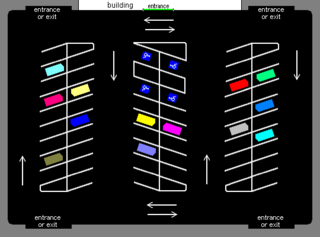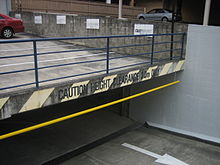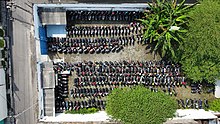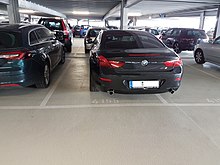Term: Parking lot
**Urban Planning and Design Impact**:
– Large-scale in-city parking disrupts walkable urban fabric.
– Historic structures are replaced by garages and lots.
– Paved areas create parking craters and deserts, acting as barriers to foot traffic.
– Parking lots are seen as depopulated areas.
– Efforts to reduce parking space to diminish car dependence are observed in various cities.
**Parking Regulations and Policies**:
– Urban planning policies influence private parking lot sizes.
– Parking minimums require a set number of parking spaces per building.
– Some cities, like Washington, DC, are considering removing parking minimums.
– Increase in bicycle parking lots as a response to environmental consciousness.
– Legal requirements for disabled parking spaces in both private businesses and public lots.
**Legal Framework and Enforcement**:
– Differences in legal obligations for parking on public vs. private land.
– Sweden and Denmark have varying penalties for parking violations on streets vs. private land.
– In the UK, police investigate accidents on public land, while civil enforcement officers enforce parking restrictions in council-run car parks.
– Legal requirements for disabled parking spaces set by each state’s Department of Transportation in the US.
**Technological Advancements in Parking**:
– Various technologies are used for charging motorists for parking.
– Modern parking lots use sensors for car occupancy detection and adaptive lighting.
– GPS and Wi-Fi technology aid in car location in outdoor and indoor lots, respectively.
– Online booking services help drivers find long-term parking spots.
**Environmental Impact and Sustainability**:
– Parking lots contribute to water pollution through runoff containing pollutants.
– Alternative paving materials like pervious concrete help filter water.
– Parking lots limit green spaces in cities due to their large land usage.
– Parking lots contribute to greenhouse gas emissions, urban heat island effect, and increased surface temperatures.
– Sustainable parking lot designs, such as solar canopy installations and tree planting, can help mitigate environmental impact.
A parking lot (American English) or car park (British English), also known as a car lot, is a cleared area intended for parking vehicles. The term usually refers to an area dedicated only for parking, with a durable or semi-durable surface. In most jurisdictions where cars are the dominant mode of transportation, parking lots are a major feature of cities and suburban areas. Shopping malls, sports stadiums, and other similar venues often have immense parking lots. (See also: multistorey car park)







Parking lots tend to be sources of water pollution because of their extensive impervious surfaces, and because most have limited or no facilities to control runoff. Many areas today also require minimum landscaping in parking lots to provide shade and help mitigate the extent to which their paved surfaces contribute to heat islands. Many municipalities require minimum numbers of parking spaces for buildings such as stores (by floor area) and apartment complexes (by number of bedrooms). In the United States, each state's Department of Transportation sets the proper ratio for disabled spaces for private business and public parking lots. Modern parking lots use various technologies to enable motorists to pay parking fees, help them find unoccupied spaces and retrieve their vehicles, and improve their parking experiences.

